Transcript, video available for Jan. 14 faculty/staff town hall
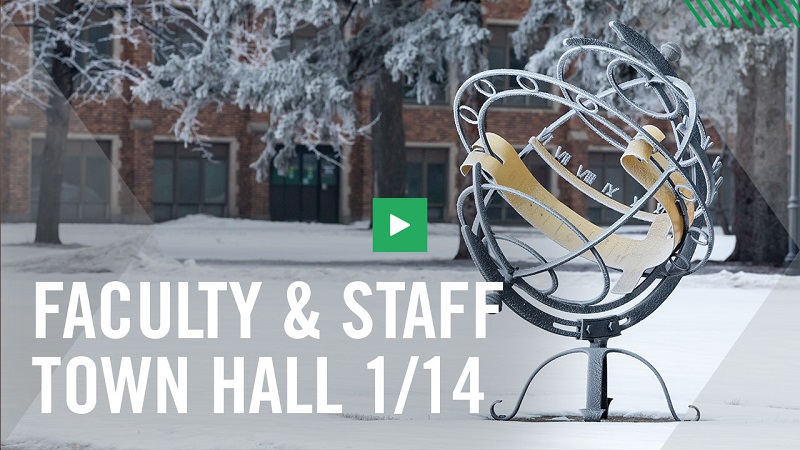 Editor’s note: The following is the lightly edited transcript of UND’s Faculty and Staff Town Hall, which was held via Zoom on Jan. 14. The transcript also includes questions and answers that were not able to be addressed during the live event.
Editor’s note: The following is the lightly edited transcript of UND’s Faculty and Staff Town Hall, which was held via Zoom on Jan. 14. The transcript also includes questions and answers that were not able to be addressed during the live event.
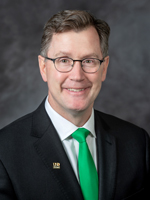
Andy Armacost
President Andy Armacost: Hello, and thanks for joining. I’m UND President Andy Armacost. Let me wish you a Happy New Year and the hope that all of your resolutions are fully achieved this year.
I know that our break gave us a chance to think about things, and really to come back refreshed. And today, we have a chance to engage with our senior leadership team.
We’re thrilled that you’re here; we’re ready to answer your questions. And we know that there’s a lot on your mind. I know that the questions today will span a number of topics, and COVID is probably at the top of the list, unless maybe it moved down.
But the issues that we’re facing here — really, we don’t know the direction of the pandemic. I urge everyone to remain vigilant and still keep after those same great things that you’ve been doing: wearing masks, washing your hands and keeping your distance.
We’ll talk about this today. But we have a new testing strategy that we’re adopting. It uses antigen tests, which gives us fast test answers within 15 minutes. But for you, probably one of the most outstanding features is that it’s less invasive. It’s much easier and more pleasant than some of the testing that you’ve done previously.
I think folks on the call here can probably attest to that.
In addition, vaccines are rolling out; you’ve seen the news reports.
We encourage everybody to get vaccinated. So test widely — once a week, if if you can pull that off, we’d encourage that; once a week across the entire campus — and make sure that you get vaccinated.
If we do these things, we can eventually get back to what I’ll call a normal life on campus.
In addition, we’re heading into the legislative session. So there will be a lot of information flowing, not just today, but in subsequent weeks about what we’re seeing with the Legislature, and about the budget proposals that we’re putting forward, and initiatives that we’re putting forward as a campus for their consideration.
In addition, we’ve talked a lot in the fall about themes and things like free speech, equity and nonviolence. And there’s no better way to celebrate that on Monday, when we honor Dr. Martin Luther King, Jr.
So keep his thoughts and his approach to nonviolence, discussion and protest at the front of your mind on Monday.
And of course, with the inauguration approaching, I just want to make the campus aware of concerns that you read about in the newspaper about potential violence — “armed protest,” I think is how they’re characterizing it — across the U.S.
Our chief of police, Eric Plummer, and his staff and the local officials in Grand Forks and in the county are watching it very, very closely to see if there’s any indications. The good news is there are no indications for violence or protests here in Grand Forks. But we’ll keep the campus apprised of any changes to that status.
Those are just a couple of opening comments. I know there’s a lot on your mind. So I’ll turn it over to the Vice President for Finance and Operations, Jed Shivers, who will do another wonderful job of emceeing and moderating today’s discussion. Thanks, Jed.
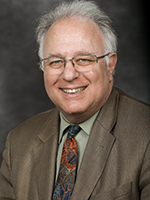
Jed Shivers
Jed Shivers, Vice President for Finance & Operations: Thanks, President Armacost. So hi, it’s Jed again. And as you heard, I’m the Vice President for Finance and Operations.
And I thought we would jump right into a few questions which have been asked of us prior to this meeting. And hopefully, that’ll give all of you who are watching and participating a chance to devise some questions of your own and get them in there.
So let’s start with a good one, and it’s all about vaccines. I think that’s a really good-news piece of what we’re talking about, although right now it’s a trickle — but soon it’ll broaden into a bigger stream.
Let’s just continue with our first question. The federal recommendations for vaccine prioritization lists college faculty and staff with K-12 faculty and staff. So in other words, they’re all kind of grouped together as educators. This is in terms of priority of how quickly people get the vaccine.
But the North Dakota Department of Health vaccine prioritization guidelines do not have college faculty and staff listed with K-12. Are there any efforts to changing this to follow the federal recommendations? And I’m going to look toward both President Armacost and Dr. Wynne on this question.
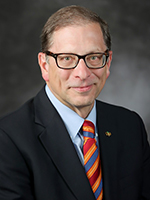
Joshua Wynne
Dr. Joshua Wynne, Vice President for Health Affairs and Dean, UND School of Medicine & Health Sciences: Good question. This issue has been brought up not only at UND, but also for the University System.
I head up the Smart Restart Task Force for the University System. And I can assure you that this question has been taken up by Chancellor Hagerott and has been brought forward to the Department of Health and their ethics committee.
There’s an ethics committee in the state — a five-member committee that helps recommend policies for the unique environment of North Dakota. So the recommendation that came out to this ethics committee, and the chancellor on behalf of the entire University System, actually has petitioned them to reconsider the very issue that you’ve asked about.
So yes, the University, but even more, the University System is pursuing this at the highest level, and we expect to hear some response in the near future.
(In other words), the request for reconsideration has been entered and is being considered.
President Armacost: Josh, just one other point I want to emphasize is that those in our community, our campus community, who are in high-risk categories will still benefit from their prioritization in the scheme. So if you’re over a certain age or have pre-existing conditions, those members will be taken care of under the current plans.
I know other states have prioritized university faculty and staff alongside K-12. Our state did something different, and I think what other states are doing might help us argue the case at the state level. So thanks. Great question.
Jed Shivers: Thank you. Next question, which I can comment on a little bit: did access to federal funding to support UND’s COVID efforts end in December? Are there other sources of funding — state and/or federal — that are available to UND to cover any costs incurred to UND as a result of the pandemic this spring?
This is a story that’s actually unfolding. As you may know, we got — through our efforts, — about $20 million to support COVID across a whole panoply of activities, everything from putting up plexiglass guards in places, to improving online education, to literally the PPE, the personal protective equipment that we need to be able to work with, to tens of thousands of masks, etc., etc.
And those dollars were originally good until Dec. 30.
One of the changes that has been made by Congress is those dollars are still available after Dec. 30. So as Dec. 30 approached, they changed their mind, which is fine. We’ve pretty much spent all of our dollars in all the ways that we mentioned.
The good news is, we have lots of PPE. And right now, all the stuff that we did to make the campus physically better is already in place. Mike Pieper has done a wonderful job on all the air handlers where he’s gotten funding to do that.
So there’s a lot of stuff that’s been made, both in terms of consumable supplies and capital stuff, that’s done.
So now the question is going to be, what happens in the spring semester?
Well, it turns out that in the current version of the latest stimulus package, there are dollars that appear to be going to be allocated to institutions of higher education on a purely formulaic basis, not dissimilar to the money that we got from a different source than the $20 million that I alluded to.
And we’re just waiting to see exactly how that’s going to come to us, and when. In fact, there’s a phone call at 2 o’clock this afternoon that’s been sent around from the Department of Education, to provide that information.
And some of us will be monitoring that phone call. It’s obviously with thousands of people, and we’ll see what else we can learn.
But there will be some additional dollars that will come from the federal government.
And then in addition, we have a group that’s been looking through this new stimulus legislation to see if:
- a) there any other additional dollars we can get, which will benefit us directly.
But in some ways, more importantly:
- b) whether or not we can connect students to dollars, which could benefit them. Because you know, students are having a rough time of it still. And so there’s things like SNAP, which is food assistance. There’s some rental assistance in here.
So we want to make sure that we’re advocating not only for direct acquisition of funds to support our educational and research endeavors, but also to get students access to funds that may be available to them.
That’s exactly where we are at the moment.
Let me go to a question which has just popped up. And I say that just because it popped up on my email: what’s the plan for the summer and fall 2021 semesters as far as delivery of classes? I’m turning to Provost Storrs. What are your thoughts?
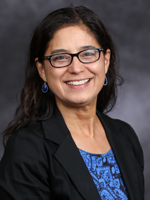
Debbie Storrs
Debbie Storrs, Interim Provost and Vice President for Academic Affairs: Thanks, Jed. Hi, everyone. Thanks for joining us today.
Currently, what we’re doing with the registrar is planning the summer/fall 21 with COVID class capacities, and hybrid delivery.
Now, we can shift as we get more information about how many people are vaccinated, and the level of health concern; we want to prioritize health and safety.
So currently, as you’re thinking through the summer and the fall, we’re going to stay with the COVID capacities in hybrid deliveries. But we can always shift.
Our goal, of course, is to return to a situation where we can teach students in class with a regular class capacity. But we want to be very careful and cautious moving forward with planning.
So that’s what we’re going to be doing right now.
Jed Shivers: Thanks, Debbie.
Next question, I’m going to come back to some health-related stuff related to COVID.
The state of North Dakota is canceling the mask mandate as of Jan. 18. Is this a little premature with classes starting this week, and even if remote, students are still on campuses across North Dakota?
Here, I’m going to turn to Josh Wynne. Any thoughts on what’s happening with the departure of that mask mandate statewide?
Joshua Wynne: Thanks, Jed, and a great question.
I think that the current mask mandate goes through that date. I don’t think it’s been determined yet that it would not possibly be extended.
I think that would be a prudent thing to do, and that recommendation has been forwarded.
So I will say for sure, as far as my personal behavior and my family’s behavior, it will continue to do that. I would assume the University would continue its current advisory as to what to do, because in fact, this relates to the prior question. Until we really get to what has been called herd immunity — which is where at least 2/3 to 3/4 of the population has been vaccinated or has had natural infection — we’re not going to have an end to this pandemic.
So it is my expectation that masks will be needed for the foreseeable future.
Jed Shivers: Thank you.
Next question is again on the same theme, a little bit health related. The question is, have the guidelines that should be followed for close contacts been revised — i.e., quarantine after being exposed to a positive employee, etc. — as the ones posted on the UND website are not being followed by some departments at UND?
Rosy, do you want to comment on that?
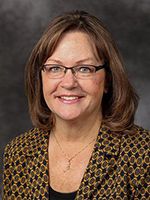
Rosy Dub
Rosy Dub, Director of UND’s COVID Clinical Response: Sure, I’d be happy to.
This is Rosy Dub, and I’m the director of UND’s COVID clinical response.
The guidelines are posted and they are recommended to be followed, and we’re adhering to them.
Our guidelines for UND employees is, if you’ve been identified as a close contact, you are asked to quarantine.
With that, I think it’s important for us to remember that there are people who have experienced having had COVID already, and they’re in what’s called a presumed period of immunity for 90 days.
So some people that may have been identified as a close contact are not being required to quarantine.
So, unless we all know the history behind some of the people that we think are violating that, there may be occasions that they really are in compliance.
I would caution people that if you have concerns about a fellow employee who should be quarantined and is not quarantined, please speak to your supervisor, and that supervisor can ask me about that as well.
The other good part is that what has happened, if you remember back when there was such a large load of cases in North Dakota, the North Dakota State Health Department was not able to continue the robust contact tracing program that they had started. The good news is they have resumed that ability.
So, now if somebody is a close contact, they will be notified by the State Health Department. Case investigations of a positive case are being done as they always have been.
But now the contact tracers are again back to notifying those close contacts and providing them information.
There also are changes that are on the web page that are probably kind of confusing to understand.
The period of quarantine for close contact has been reduced from 14 days to 10 days. In addition to that, if somebody is able to have a negative COVID test within 48 hours of the end of their seventh day, they can technically be released after their completion of seven days.
So basically, if I’m identified as a close contact, and I’m put in quarantine, if I have an antigen test — whether it’s antigen or PCR, the rapid test or the deep nasal RotoRooter one — if I do that on day six and those results are negative, I can be released from my quarantine after the completion of Day Seven.
In all those cases, those employees and those people are still asked to self-monitor for the complete 14 days.
Even though you’re released, you still have to, as always, be alert to symptoms and be careful with that.
I’d be happy to take any of the questions if there’s some related to that.
Jed Shivers: We will most definitely get back to you if there are.
Let’s turn to the flip side of this. Now, this is really a topic which we have alluded to earlier, but it’s a day that we’ve been waiting for. So I’m going to ask Jessica Doty to comment on the plan and the actuality of vaccinating people here on this campus. Would you mind going ahead?

Jessica Doty
Jessica Doty, Director of Student Health Services: Hi, I’m Jessica Doty, the Director of Student Health Services. It’s kind of an exciting day; the last two days, Student Health Services has been starting their vaccination process for the Phase 1A.
We are an enrolled vaccine provider. So, we received an allocation to start vaccinating some of our medical, nursing, and health-sciences related fields that are going to be doing clinicals this spring.
So we’re doing vaccines on campus — actually yesterday and today — which was both real and is happening on campus.
A little bit more about the plan for vaccinating faculty, staff and students. We’re including all faculty, staff and students in our identification of who is eligible for vaccine, according to the tiers that the North Dakota Department of Health has established.
I’m working to identify those groups, and we’re communicating via email when people are eligible for the vaccines because we’ve received vaccinations.
I need to say it’s a very fluid situation. We’re working very closely with our community partners. Things are changing quickly; even this morning, plans within our community are changing a little bit.
And so, working with our local health care system, the Grand Forks Public Health, we will work to either get people vaccinated here on campus or working with community members to — as the vaccine is available — get them the vaccine when they’re eligible for it.
So that’s currently the plan.
If people have questions, I would ask them to email the UND Student Health email address. If you have questions about where you would fall in the plan. I think that’s probably one of the biggest questions people have.
And just keep watching for communications and emails as vaccine allocations become available to us.
Jed Shivers: Just one quick follow-up question, Jess. Do people still have to wear masks or face coverings after having been vaccinated?
Jessica Doty: Yes, that’s the current guideline. And I would ask if Dr. Wynne can help chip in a little bit for further explanation as to why that is the rule.
Joshua Wynne: Thanks, Jess.This is a very important point, so thanks for emphasizing it.
The answer is absolutely, unequivocally, yes. So what’s the reason for that?
We wear masks for two reasons. One is to prevent us — the individual — from inhaling the virus and getting it in to our body, but also to protect others, where we spread the virus to other people.
We know that the vaccine works extremely well to protect the individual. So if I get vaccinated, after my second dose, I have a 95 percent chance of not getting COVID, especially a serious case of COVID.
But what we don’t know is whether I could still harbor the virus, even though I’m not ill, and transmit it to you.
So after vaccination, until this question is answered, it is absolutely mandatory that people continue to wear masks, and to do the other safety things. Because you could be, in essence, a silent carrier. It’s unlikely that you will get sick, but it’s very possible that you could make someone else sick.
So please continue to wear your mask, even after you’ve been vaccinated.
Jed Shivers: And just to continue to riff very briefly on the subject of masks, the question is: will there still be a UND mask mandate if the state lifts the mask mandate?
I think you’ve heard Dr. Wynne’s thoughts about that larger question.
From my current understanding — and people may have a different one based upon the more recent meeting — but as of earlier this morning, it seems as though the county will go ahead and continue to support a mask mandate for the county.
I would say that we should be really including in our thinking the notion of wearing your mask, which of course, as you can see, I always have right here, branded and everything.
You know, you get used to it.
President Armacost: In addition, let me just chime in. Even if the county did not come with a mask mandate, UND would continue with ours.
Prudence dictates that we take the precautions that the science tells us to. So, the answer would be yes, the mask mandate would continue, even without a gubernatorial or county-level mandate.
Jed Shivers: Thank you. So we’re going to do one more vaccine question. And this is a good one, it’s actually very important for people with white hair.
Will UND faculty and staff receive an email when we can receive the COVID-19 vaccine? Will it be given at UND, or do we have to sign up for a vaccine through Grand Forks Public Health?
Jessica Doty: I can help with that. I wish there was a really good clear answer on this, but I think things probably are evolving as we’re sitting here.
We’re working with the community to coordinate this. And so I believe, yes, you will receive an email. Will it be given here or at Grand Forks Public Health? I don’t know yet.
But likely email communication is the place that you should continue to watch for instructions as to when you’re eligible and where to go receive the vaccine.
The reason for that is just making sure that the allocations are getting to places and we get you to the place that there is an allocation as quickly as we can.
So I would stay tuned, but keep watching email. Because yes, that will be the primary mode of communication.
Jed Shivers: Thank you; a really accurate answer, I think. And it’s evolving.
I think it’s very important to realize that you can look across at other states, and it’s a lot worse in other states than it is here, let me tell you.
My father is 90.5 years old. He should have been vaccinated some time ago; doesn’t even know where to go. And he knows how to get there; he can navigate.
Now we’re going to switch topics a little bit.
I think one of the signs that we’re starting to think ahead, which is really good, and it’s not just COVID COVID COVID is, as President Armacost mentioned, we’re coming into a legislative session.
So a quick question, and I can help, but I’m going to direct this primarily to the president: is there any sense from legislative and executive contacts (in Bismarck), what the higher education support and funding approaches will be this next biennium?
President Armacost: Next week on Monday (Jan. 18), I’ll be presenting to the Appropriations Committee of the Senate. We’ll get more input from them at that point.
Right now, we’re planning toward what we call our needs-based budget, which is what the current legislation — our statewide funding formula for higher education — actually dictates.
You’ll recall that the governor had suggested a 7.5 percent cut to that amount.
But again, this process will unfold in real time, and the discussions and the revenue projections for the state will certainly inform the direction that we go. But right now, we’re planning against the baseline scenario of that needs-based budget.
We’re also looking at some alternate scenarios in case in case the governor’s proposal is actually adopted.
We’ll get good information back to the campus as we get more data and information from the Legislature and our contacts.
Know that we’re putting up a website together; Jed, you can probably address where we’re hosting it. But that website will have links to the status of all the bills and the discussions that are happening in the legislative sessions.
In addition, we’ll post the information that we’re presenting as a campus so that you have access to that information as well.
Jed Shivers: Thank you, President Armacost. Carla, can you maybe post the website address if it’s there for the participants in this meeting? The address that President Armacost just alluded to?
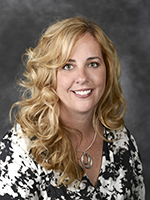
Karla Stewart
Karla Stewart, Associate Vice President for Finance: Sure. And just for reference, it is under Jed Shivers’ main homepage. So you can go out there yourself, but I will actually send out a link that directly gets you there. But if you want to take a look, it’s under the Vice President for Finance and Operations’ main page.
Jed Shivers: Another question related to the upcoming budget was, what do you intend to present to the Legislature on Jan. 18, related to wages and benefits for staff?
Really, what we’re doing is following the State Board of Higher Education recommendations.
The governor actually started with a 2 percent (raise), and followed by a 2 percent merit pool, which is not a bad place to start.
The State Board of Higher Education is at 3 – 3. And that is where we are starting.
Further, as far as I am aware, there does not appear to be any intention at this time — now, the question is, who’s intending what? — but intention at this time to have employees pick up things like health insurance, which has been discussed in prior biennia.
Those are really the two primary drivers of where we are right now. Hopefully that answered that question.
Now, again, also starting in the theme of, you know, what’s it going to look like when we return to work? Here’s a question for Peggy Varberg, who’s our Associate Vice President for Human Resources, and also Debbie Storrs: What are the return-to-work plans for non-teaching faculty and staff who work in more crowded spaces/shared offices?
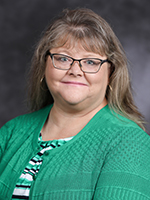
Peggy Varberg
Peggy Varberg, Associate Vice President for Human Resources: Thanks, Jed. That’s a great question.
We want to continue to encourage folks to be less dense in their populations and in office areas where we have less space between workstations. We still continue to encourage that less density. So allowing people to rotate schedules, to work from home, this has worked well in most areas.
So for the foreseeable future, until we understand what our positive rates are, how our vaccinations impact our community on campus, and so forth, we will continue to encourage those thoughts.
Beyond that, remote working has worked well for a lot of folks. We encourage you to continue to have conversations with your supervisors to make sure they understand your perspective, especially if you’re concerned about a workspace currently. Continue to have those conversations.
I think for the next several months, we’re going to see still a less populated campus, simply because there are unknown factors. Our vaccination rollout’s going to be a great plan. And hopefully we’ll see positive impacts, as the state and federal governments work through that, in outcomes of how vaccinations impact our communities.
And then positivity rates; I think that’s important to keep our eye on that.
Debbie Storrs: Peggy, I would just add that, yes, absolutely we want a less dense campus. And we need to recognize that students are on campus as well.
So, faculty and staff who aren’t in their offices, but continuously are providing office hours and other services virtually, have been doing a great job. We’re encouraging people to make sure they have signage so students know how to reach you if they need to reach you.
And then for service units, support units, when students call or when faculty and other staff call to get hold of somebody, those lines should go directly to a phone with somebody answering, so that we can provide the quality service that we’re all so proud of.
Jed Shivers: One question which has come up based upon prior conversation concerning the legislative session: based on what President Armacost said about presenting about UND priorities, how can UND faculty and staff best support and help make the case?
President Armacost: Our goal is to make sure you have the information that we’re presenting. So I think having that baseline understanding is the first thing. Pay attention to the communications that I’ll be making, and the other vice presidents will be making to the campus on this matter. Take a look at the website and pay attention to the bill drafts that are being put forward by the legislature. I think if you read through them there is a surprising level of detail. I understand there are over 600 bill drafts right now, and probably several dozen that involve UND and the NDUS. So, the first thing is to keep yourself informed.
The second is in your engagement with the public, and, if you happen to run into legislators, talk about the great things that are happening at UND. What we’re trying to do is convey to the state that investment in higher education and investment in UND is an essential component. It helps us overcome economic downturns. It helps us diversify our workforce, to prepare them with the right comprehensive education, founded on a great liberal arts component, as well as the majors that everyone is taking. The way that we educate and that we develop them and have them serve the state of North Dakota and other states quite well. Just have it on the tip of your tongue the ability to articulate the case of UND is truly essential. That’s how you can help the best way. I’ll turn it over to Meloney Linder next to see if she has any additional comments.

Meloney Linder
Meloney Linder, Vice President for Marketing & Communications: Sure, I’ll just add in addition to the website where you will be able to monitor the bills, we’ll be doing coverage of our testimony, which will be in UND Today following our testimony on Monday. Be watching the UND Today articles, we’ll be having updates regularly when we’re testifying, to keep you up to date.
Jed Shivers: Josh, do you want to add anything, because you’ll be testifying also?
Joshua Wynne: I think both President Armacost and Vice President Linder hit the key points of be informed, be involved and be able to answer questions when you’re asked. And in that regard, I think I can say on behalf of the team, if there is something that you think is not clear, that we have not made clear, or our materials have not made clear, please speak up and let us know. We as a team have invested a lot of effort in trying to be as clear and concise as possible. But if there is something that you find confusing when you look at the materials, or you hear what we say, please let us know so that we can do an even better job representing you to the Legislature.
President Armacost: And Josh, that feedback mechanism is so important and I’m glad you brought up that point. Know that next Monday’s presentation is the first round of potentially many, and it’s not just me presenting. Many of the people that you see on this screen, the people here, are going to present on behalf of their component of the University. So, the more information we can get from you, and the feedback that you give us, will undoubtedly help us in the subsequent rounds of testimony.
Debbie Storrs: Can I just add to this conversation? We greatly protect, support and advocate for all faculty and staff to use your free speech as citizens of North Dakota. There are a number of bills coming through for consideration that you may have a position on. And I would just encourage you to be careful when you’re communicating whatever your position is – that you do so as a private citizen. And then I would echo my colleagues in that you are our best ambassadors for telling our story. Our staff and faculty are working closely with students; you’re engaged in research that matters to the state. And it’s not just the legislators, it’s talking to tax-payers of the community – your neighbors, your friends need to know the good work that you’re doing. I really support and encourage you to tell your story and how you’re making an impact on students’ lives.
Meloney Linder: Something I would add, in light of COVID, everything is being done differently this year, so you’re able to watch the testimonies live. UND will be testifying at 11 a.m. on Monday, that will be Dr. Armacost. And then we have Dr. Wynne who will be testifying for the School of Medicine & Health Sciences at 1:30 p.m.
Jed Shivers: Thank you all for participating in that question. That was a good one. Let’s now move on to another important area that the University has to think through and work through, and that’s diversity, equity and inclusion. Here’s the question: thank you for releasing the report from UND’s Task Force on Diversity, Equity & Inclusion last semester. Would you please discuss the concrete next steps the administration plans to take regarding the recommendations proposed in the report, as well as what each of the schools and departments will be doing with respect to the report? I’m looking for Vice President Cara Halgren and maybe President Armacost to answer.
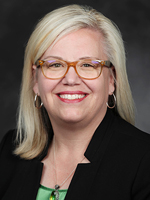
Cara Halgren
Cara Halgren, Vice President for Student Affairs & Diversity: Actually my colleague, Tamba-Kuii Bailey, and I are meeting tomorrow to talk about where we pick up after we’ve concluded last semester. And one of the things that we’ve spent time thinking about really came from you all. In one of the last sessions, you talked about the idea of having conversations with each of the colleges about what the findings in the report mean to you specifically. And so Tamba-Kuii and I have been in conversations with Provost Storrs about the idea of speaking with each of the academic deans one-on-one to get a better understanding of what the report means to them, and how we can best work with them to move these ideas forward. So I think that’s one concrete next step.
The other thing that we talked about is working on the diversity statement. One of the things that the task force agreed was that in order to keep doing this work, we had to understand as a community what it was that we believed in and why. And the best way to do that is to think about recrafting the diversity statement as we know it, and I think again that will be one of the next concrete steps that we spend time working with. I’ll turn it over to President Armacost if he has additional comments.
President Armacost: Just to reinforce everything you’ve said, Dr. Halgren. This task force did incredible work, they thought through a lot of issues. The real challenge is — well, as we know, we did great work communicating results to campus — but the hard next step is how do we embed those recommendations or next steps into the long term fabric of the institution. How do we strategically build these elements of change into the institution? So this is the significant next set of steps. And the two that you outlined are the ones that are imminent, and then we’ll build additional action plans and steps and involve members of the campus community to address other areas as well.
Debbie Storrs: I would like to add to this. The academic deans have taken a look at that diversity, equity and inclusion report, they’re well aware of it, are having conversations and I think one of the next steps for each of the deans is to consider other kinds of initiatives that may not have been accessed or considered as they think through how this might shape their own college initiatives and actions. And to Dr. Halgren’s point, I’m sure we’d welcome a conversation. We’ve yet to have that yet, because of the break. And I also will be meeting with Dr. Halgren’s co-chair, Dr. Tamba-Kuii Bailey, to learn more about his interest in advancing some of this work and helping inform academic leadership, as well. We look forward to next steps and we encourage everyone to be part of this process. One of the things that I think is really important about this work is that everybody is responsible for achieving equity and inclusion. I’m glad to see such interest in this important area.
Jed Shivers: Thank you all, another good one. Let’s go back for just a second, because quite a few people have been asking follow-up questions about vaccinations. It’s a beautiful thing to talk about. I even like the word. So, if we fall into the 1B category for the COVID-19 vaccine, specifically those with two underlying health conditions — any age — do we need to provide proof of those underlying conditions? Do Jess or Rosy have any thoughts on that?
Rosy Dub: I can take this one. No, you will not need to provide proof. At this point in time, the North Dakota Department of Health is saying that we’ll take peoples’ word for it and trust that everybody will be honest, so, no, that’s not something that will be required to have proof for.
Jed Shivers: An interesting related question, because one of the great things about our community is they think through to the end. One question is, is the vaccination going to be mandatory? And will UND cover any serious reactions that can arise with the employees’ loss of work? Let’s take the mandatory question first. And I think for that, I’m going to turn to President Armacost.
President Armacost: At this point, no plans to make vaccinations mandatory for the campus. In terms of reimbursement, let me turn it over to Peggy Varberg, our VP for HR.
Peggy Varberg: Employees would use their leave, so if they had some adverse reaction, weren’t able to work, then they would have to access their sick leave. Without leave policies, then the person would be unpaid.
Jed Shivers: The important thing here, of course – and I would like to ask Josh to comment on serious reactions that have appeared around not only our community but nationwide. A few million people have been vaccinated. But of course the other side is that we are not going to be forcing people to be vaccinated, there are no plans to make it mandatory. I think that’s the fundamental premise of the question. The answer is no, at least we aren’t planning to do so at this time. Josh, do you want to talk a little bit about adverse reactions, give them a sense for that?
Joshua Wynne: I would very much like to, as I think it’s important for all of us as educators to make sure that the facts get out there. This obviously has evolved as more and more people have been vaccinated. Point number one is that the risk of complications from the COVID vaccine is far less than the risk from COVID itself. Overall, COVID has a mortality across the board of around 2 percent. That is 20 times the risk of mortality as with influenza. The risk of the disease is very high. The risk of the vaccine is very low. But there are some things, let me touch on them. One, overall, the most serious side effect you typically see is called anaphylaxis where the person develops low blood pressure, hives, trouble breathing. That typically occurs one in a million with many vaccines, so it’s extremely rare. Obviously it’s serious when it occurs. It appears that anaphylactic reactions to at least the Pfizer vaccine – we don’t know as much about the Moderna yet – is somewhat higher than that. Maybe half a dozen per million. That is still far below the risk from COVID itself. Additionally, when you get vaccinated, you will be asked to stay in the area where there is resuscitation equipment, should you have the very unlikely eventuality of this anaphylactic reaction that typically occurs within the first few minutes of being vaccinated. So we can reduce the risk that even if you do get this extremely rare complication, that immediate care will be available to help deal with that. The bottom line is that there is a finite risk to vaccination. It is extremely low. And the risk/benefit ratio is far in favor of getting vaccinated, rather than not and taking your chances.
Jed Shivers: Thank you, I think that is really important information to get out and, as usual, done in a very succinct and clear fashion. We really do encourage people to get vaccinated. We will not make it mandatory, but I think it’s fair to say that the University strongly encourages to take advantage of this — really important.
Joshua Wynne: May I mention one more thing, if that’s ok?
Jed Shivers: Please do, and then I think Rosy may also comment.
Joshua Wynne: There are actually two reasons to get vaccinated. One is to protect the individuals, so if I get a shot in the arm, that’s great for me. But guess what? It’s also great for you. The more people we can get vaccinated, the quicker we’ll get to what’s called herd immunity, which is that condition where you don’t need to have everyone vaccinated and they still get protected. The herd protects those who may not yet be vaccinated or can’t be vaccinated or won’t be vaccinated. That requires something like two thirds of us, or maybe higher at three quarters, to have the vaccine or have protection because we got COVID. So there are two reasons: personal but also community.
Jed Shivers: I think we should start talking about flock immunity as opposed to herd immunity. It just bugs me for a reason I can’t identify, sorry. Another one, which is getting back to normal, is will there be any summer camps on campus this year? Will all residence halls be empty when school lets out in May? And here I’m turning to both Cara Halgren and Debbie Storrs.
Cara Halgren: One of the greatest things about summer at UND is seeing all of these young learners all over campus. And there is nobody that is waiting to have some of those young folks back more than we are. We’re still watching to see what happens with COVID, but we are certainly open to welcoming people as soon as it is safe to do so.
Debbie Storrs: I would just add that on the academic affairs side of the house, we do a lot of summer camps. Research camps, summer camps. I’ve encouraged folks in organizing those to plan them virtually. Hopefully we can get to a place where we do some virtually, but at this point in time the safer bet is to plan virtually.
Jed Shivers: Thank you. So, I think, people are really interested in the testimony that’s coming up. And, one question was, “Can you provide the links to watch the testimonies on Monday?” I’m going to turn to Meloney.
Meloney Linder: Go ahead, Carla.
Karla Stewart: I’m sorry. I already posted the link in the Q&A and also on the chat.
Meloney Linder: We have a four-page document with each of the legislative asks talking points. We can put the PDF of that on the website for the legislative session so everyone on campus would have the talking points around each of the asks. And we can post the presentations that are done by UND and the School of Medicine and Health Sciences following our Monday testimony.
Jed Shivers: Thank you, Meloney. Keeping with that theme. A question is, we can only “lobby” or discuss as private citizens, right? So I’m going to turn to Debbie and Andy, for that.
Debbie Storrs: Yes, I mentioned this earlier. We encourage the free speech of all our staff and faculty or community members, and to identify when they are speaking as a private citizen on whatever topic that they choose to speak on. It’s important that we’re engaged in the state and state decisions as citizens. You just want to be careful to distinguish that you’re speaking as a private citizen, and you’re not using UND property when you’re engaging in that kind of communication with representatives or others. President Armacost, do you want to add anything to that?
President Armacost: Just a note that there are some members of the faculty and staff who might be called to testify as representatives of UND. And it will be clear in that case, when they are. But, if you do engage, do it without your affiliation to UND and without your title.
Joshua Wynne: If I might add to this. This is what many of us will be doing: provide information and answer questions. And we can do that on behalf of UND. But it’s important that we have appropriate authorization to do that. So, when we’re answering questions, it’s important that we have the approval from the appropriate personnel, whether that’s the President or Meloney or whomever, to answer questions and to provide information. That we certainly can do. And, President Armacost and I will be testifying, and others will be testifying on behalf of UND. But, much of it is to provide information rather than promote a particular bill or points of view.
Jed Shivers: Yeah, when we testify, we really are there to provide cogent information to the legislators. We’ve talked about vaccine, we’ve talked about returning, but there are people who really are still, I think, quite justifiably concerned about their health when they’re at the workplace. And so I’m probably going to be looking towards Rosy for this question. If an employee is identified as a close contact, are they exempt from quarantining if they said they are wearing masks, even though they did not adhere to the social distancing for a long period of time while they were with a positive employee? Hopefully I didn’t screw that question up too much.
Rosy Dub: I read the question too, so I’ll try to answer as best I can. Employees are not allowed the option to self-monitor versus quarantine because they’re wearing masks. If you read the state of North Dakota does allow self-monitoring where two people were both consistently and correctly wearing face coverings and then they’d been identified as close contacts. They do not have to quarantine. They can choose to self-monitor instead. However, quarantine is still the preference. UND has set our bar that we want to enforce the quarantine of someone who’s been identified as a close contact for employees. So with that, it kind of goes back to the same question that we had earlier: yes, if you are an employee, and you both were wearing face coverings, and you’ve been identified as a close contact within six feet of a positive case for 15 minutes or more, over 24 hours, you don’t have to quarantine, provided you’ve had COVID and you’re under that presumed immunity. I hope that answers the question.
Jed Shivers: Thank you. Along that same theme, someone has written, Peggy, thank you! I am concerned about employees not staying home as they must use sick leave, and some may not have it. If I’m a close contact to a confirmed positive case, who determines if I go home or not? And so that may be as much a question for Rosy, as a contact tracing function, as it is for you.
Peggy Varberg: As a close contact, you’ll be identified by the person who tested positive, and our contact tracers are going to know who that person is, and they’re going to get communication about that. So then, as a UND employee, we’re required to report that. We have a reporting mechanism, we use Veoci. We continue to encourage people to follow that process. If they are a close contact, they will be asked to quarantine. As Rosy mentioned, it’s not 14 days anymore. It’s 10. There is a little bit of “get out of jail earlier” with testing opportunity. So that’s great. So the time is potentially less than a full 14 days as before. With regard to leave, if a benefited employee exhausts their leave, we do have a policy and process to allow in that circumstance for a person to go in the hole with their leave. They would continue to get paid, but their leave levels would go negative. But that’s an opportunity for us to continue to offer that leave. So, Rosy, what did I miss?
Rosy Dub: I think you covered it well, Peggy. I’m kind of wondering if I’m going down the wrong road here but I think it would be important for people to understand, too, that there really isn’t an enforceable law — I’m not speaking of UND; I am speaking for the state in general — if somebody violates quarantine. They’re not going to get arrested. That’s the way to put it. There is potential, if somebody violates isolation, if they’ve been identified and they’re not abiding by the isolation, that county health officers can put out an order that does have some legal ramifications to it. I am speaking in general, not really specifically for UND.
Jed Shivers: Thank you. I’m going to switch gears for a second and talk about vaccine. But really this is, again, a real sort of thinking-through type question. It’s all about the vaccine and what it looks like to return to normalcy. If the vaccine is not mandatory, then how can we return to offering in-person labs and other types of classes that require close contact between groups of students and/or faculty and students? Can departments require the vaccine in order to offer a normal lab experience for students who choose to vaccinate? Debbie, do you want to try that one out?
Debbie Storrs: Sure. I would refer back to Dr. Wynne’s discussion about group immunity. The faster we get there, the more likely we are able to return to in-person experiences, while we continue to wear face coverings or masks. We’re going to have to continue to do that for I don’t know how long in the future. I don’t think that’s something that’s going to go away quickly. And in the meantime, that’s why we’re planning to continue with the COVID capacity in labs and in classrooms to ensure safety. And, as we noted earlier, we are not requiring vaccinations of students. The exception has been in cases where students are working in healthcare. We can require that as a component. Anybody else want to add to that?
Joshua Wynne: One of the things that’s going to determine what happens on campus is what’s happening in the community. We’re not going to be absolutely positive of what might happen in the classroom. You also are not going to be positive about what might happen in a restaurant or a store or whatever. But if we see the numbers in Grand Forks County, as an example, at an extremely low level, that will be very reassuring, and presumably, is because enough people have gotten vaccinated and so forth. So, we won’t know for sure but we will have empirical data that support the University then considering lessening the requirements as far as masks and so forth. We’re not there yet. And, that’s going to be third quarter of this year at the earliest. But I think a good way for us to gauge what’s safe on campus, is what’s going on in the community.
Jed Shivers: Thanks. So we have time for one last question and then I’m going to turn it over to President Armacost. Very quick question for Mike Pieper. Don’t want to leave you out, Mike. “If there are no students on campus this summer, and I don’t know if that’s completely accurate, are BSTs going to continue to work?

Mike Pieper
Mike Pieper, Associate Vice President for Facilities: I will probably bring up two pieces of information that occurred last summer. We worked with our BSTs to kind of jumpstart our summer cleaning earlier in March when the campus was shut down. And, we got to a point where we were in a position that we had done enough pre-summer work before summer started that we were in a good position to open up in the fall without delay. The second factor, though, back last summer was the federal government had some additional COVID unemployment relief that would bridge the compensation for those employees that got furloughed. So if there was no students in the summer, we may run into a situation where we run out of work prior to when we normally would coming up in the fall. But we currently don’t have that added benefit of compensation from the federal government. I think, it would be a conversation the University would have to have at some point during the summer. But, the factors aren’t the same as they were last year. That’s about as clean as I can say it: to be determined.
Jed Shivers: I think it’s fair to say there will be students on campus, no?
Mike Pieper: Yeah.
Jed Shivers: Okay, so we literally are at the end of our time. Let me just turn it over quickly to President Armacost for some closing comments.
President Armacost: Just one final note of thanks for everybody who participated in the panel, but most importantly, to the 400 and some odd people who dialed in today to listen to the answers. Thanks for your patience. Thanks for your questions. And we’ll do this again in March and again in May. Our goal is to get as much information to you as we can, in the most timely way that we can. So keep doing your great work. We’re really proud of everything that you do for us. We’ll see you soon.
Q&A: Following are questions and answers that were not answered in the live Town Hall.
If a person is in close contact with a confirmed positive case, when should he/she be tested?
About five or six days after contact with the person.
Are we able to come up with a different term for group immunity (herd immunity)? We’re starting to sound like NDSU fans.
Unfortunately, that’s the accepted term, but we hear you!
Will athletes be required to receive vaccines?
Not at this point, but we are monitoring the NCAA landscape pertaining to this.


